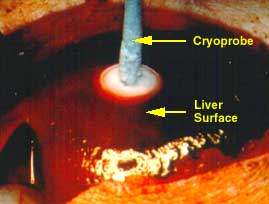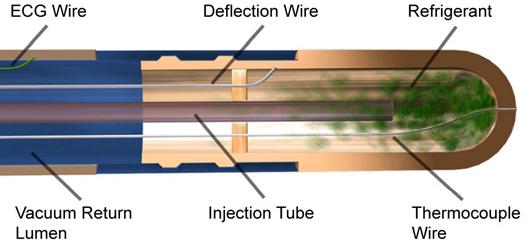Honoring Breast Cancer Awareness Month, doctors and scientists have turned toward the examination of simpler techniques for outwitting cancer growth and progression. The next cancer treatment may not be a new gamut of drugs aimed to block cancer cell metabolism, bacteria bred to eat cancer or mutant immunoglobulin that will cure us of our tumors; it may simply be cold treatment to freeze cancer tissues.
Cryoablation, the use of extreme cold in an isolated area, has been identified as a possible cancer treatment by The American College of Surgeons Oncology Group and is the center of a National Cancer Institute (NCI) clinical trial testing the success of cryoablation treatment on invasive breast cancer carcinoma.

Photo: Cyroablation technology used to treat liver cancer. "Ice-ball" is visible where cryoprobe meets the tumor surface. Credit: University of Wisconsin, General Surgery
Cryoablation technology uses ice to freeze tumors in the body tissue. The ice is extremely cold and
precisely targeted to destroy tumor cells and impairing the vasculature that feeds the cells. This process can be induced in an isolated area so that the surrounding tissue and structures are not harmed in the cryoablation process.
Although such a simple technique seems almost too good to be true, it is not a new concept. Cryoablation has been used as treatments for various conditions including arrhythmia pain caused by cancer metastasis, and fibroadenomas, non cancerous tumors located in the breast tissue. Pivotal to the study is the use of the Visia 2™ system produced by Sanarus Medical. Their cryoablation technology has been used to effectively treat benign tumors with a high degree of safety and a minimally invasive procedure. Sanarus Medical reports that 2,000 treatments of cryoablation therapy have been performed to remove fibroadenomas with no further re-growth or re-occurrence. Due to its effectiveness in treating benign tumors, researchers speculate its use in treatment of malignant cancer.
"Cryoablation has been used effectively for years to treat a number of medical conditions, including benign breast tumors, so it is a natural progression to study its use in the treatment of breast cancer," said Dr. Levine, Medical Director at Hoag Breast Care Center. "We are very encouraged about the promising initial results in our pilot study and believe further research is warranted in order to develop and refine this potential breakthrough breast cancer treatment."
Cryoablation, although not a new concept, has been greatly improved due to refined tools for its application and its coupling with imaging systems like ultrasound to allow more precise maneuvering.
A small nick in the skin can allow a small probe to enter and an “ice-ball” area is created around the probe destroying the frozen tumor cells.
Although there were other options to study for new cancer treatments, including radio-frequency (RF), interstitial laser, microwave or focused ultrasound as therapies, the safety, preliminary efficacy, and recovery rate due to minimal invasion of the body was hard to ignore, making cryoablation the best and most viable option for possible cancer treatment.
Photo: Pictorial representation of Cryoablation catheter, used in cryoablation therapy. Credit: Stanford Haptics
Mattew Callstrom, an M.D.,P.h.D. radiologist at Mayo Clinic in Rochester is a proponent for the cryoablation therapy as treatment for severe pain caused by cancer metastasis. “Cryoablation offers greater precision than radio frequency ablation, which uses heat,” he said. "You can't see precisely where the heat is being delivered in the tissue, so if you try to ablate a difficult area, you have to worry when you're near critical structures like the spinal cord, blood vessels or organs. With cryoablation, we can see the sharp line of the ice and take it right up to the critical structure and not harm it."
The NCI study is similar to initial studies conducted by Levine and colleague Dr. Steven Poplack, Co-Director of Breast Imagine at Dartmouth Hitchcock Medical Center. Both studies feature cryoablation treatment, MRI evaluation of cryoablation efficacy and further surgical and pathological evaluation of tumor response to cryoablation treatment.
Although it is too soon to know if cryoablation will be the center of next era of cancer treatment, preliminary research and observation point to continued success. Cryoablation therapy is a useful and innovative technology with numerous applications. It is quite possible that it may prove to be a more palatable and viable option for cancer treatment than radiation and chemotherapy in the future.



